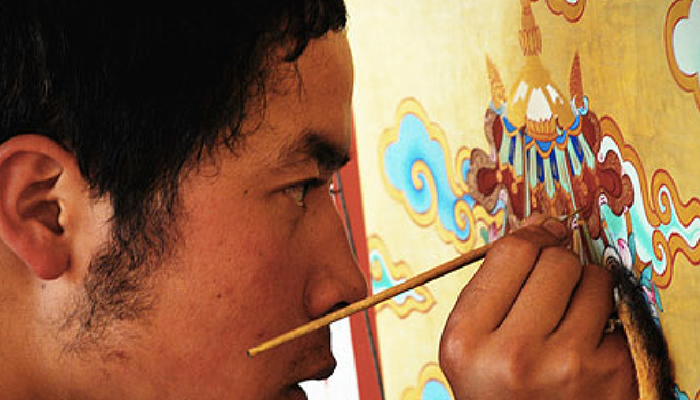Tibetan Thangka
Tibetan Thangka, also known as Tangga, is a transliteration of Tibetan language. It is a scroll painting mounted on satin fabrics. It is a kind of painting with Tibetan cultural characteristics. The core and mounting of Thangka are inseparable from the achievements of agricultural civilization such as cotton, hemp, silk and silk. "Thangka" painting originated from temples, and its inheritance history is directly related to the teaching of Xidiangang College in Labrang Monastery, Gannan, which belongs to the pure religious affairs of teachers and apprentices. Thangka painting has distinct national characteristics, strong religious color and unique artistic style. It has certain social value and academic value for the study of Tibetan folk and religious arts in China, and has the value for the world to appreciate and collect.
In 2008, it was selected as the first batch of national intangible cultural heritage expansion projects.
Historical origin
Gannan belongs to Anduo Tibetan area. Because of its geographical relationship, the local Tangka painting techniques are deeply influenced by the artistic style of the Han Dynasty. However, after all, the Gamagong School of Painting was a prevalent school in the 16th century. At present, Mian Tang School and Mian Sa School represent the new development level of Tangka's painting art.
Thang-ga, also known as Tangka, is a Tibetan transliteration, referring to religious scroll paintings mounted with colored satin and suspended for worship. According to textual research, the form of Tangka is related to the life experience of nomadic tribes. Tibetans live on the vast and desolate plateau, wrapped in a roll of Tangka, which becomes a temple with them.
Inheritance significance
In June 2008, it was selected as the second batch of national intangible cultural heritage list.
Gannan Tibetan Autonomous Prefecture in Gansu Province is rich in Tibetan culture. Today, seven local folk cultures have been listed in the national intangible cultural heritage protection list, Gannan "Tangka" is one of them. The composition of Gannan Tibetan "Thangka" painting is very unique. The whole picture is not limited by space, earth, ocean and time. In a very small picture, there are heaven, earth and earth boundaries. It can also skillfully use the deformed rocks, auspicious clouds and flowers to form a continuous pattern and divide the plot naturally to form a vivid and interesting legendary picture which is both independent and coherent. Gannan Tibetan "Thangka" painting has distinct national characteristics, strong religious color and unique artistic style. It has certain social value and academic value for the study of Tibetan folk and religious art, and also has the value for the world to appreciate and collect.
"Thangka" painting originated from temples, and its inheritance history is directly related to the teaching of Xidiangang College in Labrang Monastery, Gannan, which belongs to the pure religious affairs of teachers and apprentices. Gannan "Thangka" is mostly painted on pure cotton cloth, but also on sheepskin. It has silk embroidery and silk seam or plate printing. It is trimmed with various colors of silk and satin, covered with thin silk and decorative ribbons, and has brass and silver decorative wooden axles at the bottom for roll-up exhibition. The size of the pictures varies from tens of square meters for the larger ones to less than 0.1 square meters for the smaller ones. Its paints are mostly broad material and gold and silver.
Buddhist meaning
Thangka is the most common religious painting - Buddha statues, the general central position is to depict the main characters, starting from the top corner of the picture, around the central characters, clockwise with the central figures related to the characters, venues or stories filled a week. Each axis of Thangka generally depicts a more complete story. The scenery of the picture changes with the need of the story plot and is not limited by history, time and space. The characters in the picture are not affected by the perspective relationship between far and near, so they are arranged vividly. They unite the whole picture on the major keynote and make the composition very complete. Some Thangka area can generally reach tens or even hundreds of square meters, the composition is very complete, very spectacular.

0 Questions
Ask a Question
Your email address will not be published.